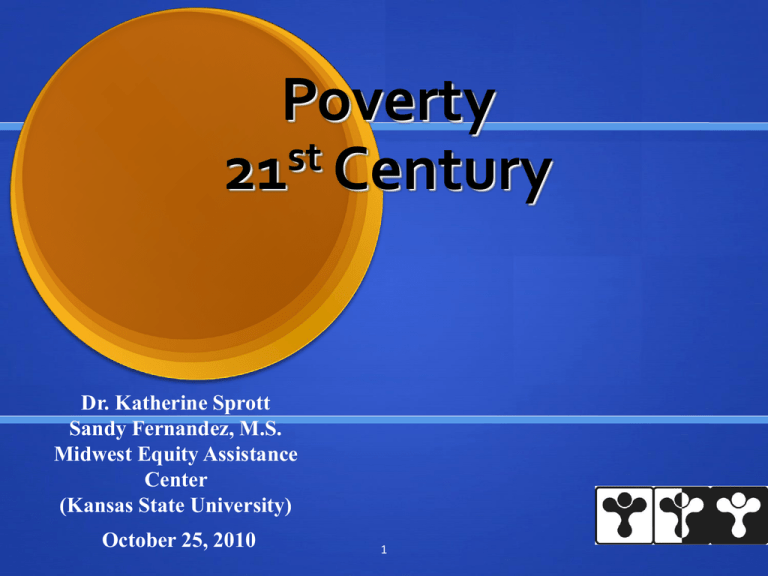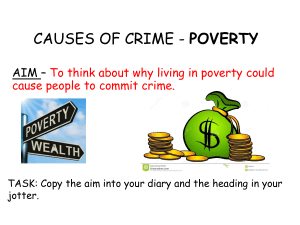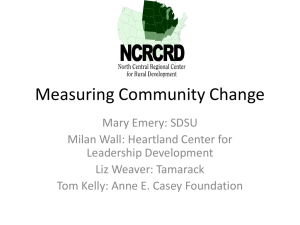powerpoint link for Third Session
advertisement

Poverty st 21 Century Dr. Katherine Sprott Sandy Fernandez, M.S. Midwest Equity Assistance Center (Kansas State University) October 25, 2010 1 Introductions Dr. Katherine Sprott Sandra L. Fernandez Ronna Olivier 2 Introduce the Technology Webinar page Left side: Chart box Box: questions Questions in the box will be answered during webinar 3 http://www.facebook.com Midwest Equity Assistance Center p 4 Objectives Myths/Realities Statistics Next session – November 15 Defining Poverty Deficit / Asset Models Identify qualities that under-resourced students need to be successful in school. Provide strategies for increasing student achievement. 5 Myths/Realities: Stereotypes Stereotypes are generalizations about a group that are applied to individuals. 6 Myth or Reality (What We Think We Know) 1. Poor people are unmotivated and have weak work ethics. 1. 83% percent of the children from low income families have at least one employed parent. 7 Laziness Stereotype: Laziness ah, but: According to the Economic Policy Institute (2002), poor working adults spend more hours working per week on average than their wealthier counterparts. Gaining employment is due to the lack of skills in many situations. (Rural vs. Urban) 8 Myth or Reality (What We Think We Know) 2. Poor people are uninvolved in their children’s learning , largely because they do not value education. 2. Low-income parent hold the same attitudes about education that wealthy parents do. 9 Don’t Value Education Stereotype: Don’t Value Education Ah, but: Low-income parents hold the exact same attitudes about education as wealthy parents (Compton-Lilly, 2003; Hale-Benson, 1986; Lareau & Horvat, 1999; Leichter, 1978; Varenne & McDermott, 1986). 10 Myth or Reality What We Think We Know 3. Poor people are linguistically deficient have lack of intelligence. 3. All languages varieties are highly structured with complex grammatical rules. 11 Language/Knowledge Deficient Stereotype: Language- Knowledge Deficient Ah, but: Linguists have known for decades that all varieties of English (such as “Black English vernacular” or Appalachian varieties) are equally complex in structure and grammar (Gee, 2004; Hess, 1974; Miller, Cho, & Bracey, 2005). An abundance of communication is expressed in other ways. 12 Myth or Reality What We Think We Know 4. Poor people tend to abuse drugs and alcohol. 4. Poor people are no more likely than their wealthier counterparts to abuse alcohol or drugs. 13 Substance Abuse Stereotype: Substance Abuse Ah, but: Alcohol abuse is far more prevalent among wealthy people than poor people (Galea, Ahern, Tracy, & Vlahov, 2007). And drug use equally distributed across poor, middle class, and wealthy communities (Saxe, Kadushin, Tighe, Rindskopf, & Beveridge, 2001). 14 Myth or Reality What We Think We Know 3. Poor people are involved in violent crime. 3. Poor people crimes are more visible to in media. 15 Crime and Violence Stereotype: Crime and Violence Ah, but: Poor people do not commit more crime than wealthy people—they only commit more visible crime. Furthermore, white collar crime results in much greater economic (and life) losses than socalled “violent” crime. 16 Questions!!!!!! 17 What Is the Origin of Stereotypes? Media Culture Geographical/regional Peers Historically/ passed on by family Generationally passed on by family 18 What Can We Do? Confront our own “mental baggage” about students. Reject deficit theory and help students and colleagues unlearn stereotypes. Never assume all students have equitable access to resources. Ensure that learning materials do not stereotype poor people. • Gorski (2008), Thompson (2010) 19 Reflective Questions Who am I and who are we in terms of the students we serve? Why do we do what we do? How will we develop and use the skills that we have to successful educate our students? In what specific behaviors will I or we engage to be more effective? • Lindsey, Karns, Myatt (2010) 20 Reflection Question Is poverty an individual experience or a systemic condition? 21 Individual and Systemic Health Care Literacy Development Parents Neighborhood Rothstein, R. (2007), Gorksi, P. (2008) • Absence/Truancy due to illness • Irritable: cognitive/behavior • Underdeveloped complex language • Underdeveloped vocabulary • Low-wage employment • Frequently laid off: stress • Higher crime and drugs • Fewer role models 22 National Poverty “A Blueprint for Reform: The Reauthorization of the Elementary and Secondary Act” (2010) 20% of elementary school students attend high poverty schools 14% White 34% Black 46% Hispanic 4% Asian 2% American Indian 6% of secondary school students attend high poverty schools 11% White 34% Black 44% Hispanic 4% Asian 3% American Indian 23 State Poverty 5-17 year olds Iowa Missouri 10.5% 21.0% Kansas Nebraska 13.5% National Center for Education Statistics (2007) 11.4% 24 Educators Nationally Teachers in high Teachers in low poverty schools 62% White 16% Black 18% Hispanic poverty schools 93% White 3% Hispanic 2% Black A Blueprint for Reform (2010) 25 Educational Attainment High Poverty Teachers Lower attainment of master degrees for both elementary and secondary level Secondary Level 38% had masters degree vs. 52% in low poverty Both Elementary and Secondary level teachers had less than 3 years teaching experience 26 Educators Locally In your local schools, districts and classrooms, what does your data imply? How are students served? 27 Students Nationally Race/ethnicity 14% White 34% Black 46% Hispanic 4% Asian 2% American Indian 28 Students by Race/Ethnicity Iowa Missouri White 10.5% White 12.9% Black 37.4% Black 32.4% Hispanic 28.0 Hispanic 35.6% Other 21.1% Other 25.4% Kansas Nebraska White 12.1% White 10.3% Black 28.5% Black 24.45 Hispanic 33.4% Hispanic 24.9% Other 18.9% Other 13.6% Kaiser State Health Facts 2007-2008 29 What can we do? Start with your data. (Ed Trust) Teacher Certification Experience Licensure performance Value Added measures the growth of individual students using standardized achievement tests. Value Added scores reflect the academic growth of each student in each content area from one year to the next Value Added scores eliminate traditional reasons for success or failure on achievement tests (race, ability, socioeconomic status, etc...) 30 What We Can Do? Student attendance Drop-out rates Graduation rates Credit earned for graduation (D,F, or I Enrollment in advance placement, gifted and Algebra I Suspension and expulsion rate Special Education Bilingual Education 31 Questions!!!!! 32 Picture Insights!!! Generate a list of thoughts in group. Share the group thoughts. Analyze the thoughts 33 Reflect and identify the characteristics of the picture on facebook discussion. (The picture will be posted on facebook as well). 35 Questions/ Thank You Dr. Katherine Sprott Sandra Fernendez, MS. Kansas State University Kansas State University (Midwest Equity Assistance Center) (Midwest Equity Assistance Center) krs8888@ksu.edu sfdz@ksu.edu 785-532-6408 785-532-6408 36








